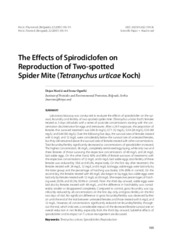The Effects of Spirodiclofen on Reproduction of Two-spotted Spider Mite (Tetranychus urticae Koch)
Efekti spirodiklofena na reprodukciju običnog paučinara (Tetranychus urticae Koch)
| dc.contributor.author | Marcic, Dejan | |
| dc.contributor.author | Ogurlic, Irena | |
| dc.date.accessioned | 2015-10-31T17:30:52Z | |
| dc.date.available | 2015-10-31T17:30:52Z | |
| dc.identifier.uri | http://arhiva.nara.ac.rs/handle/123456789/1270 | |
| dc.description.abstract | Laboratory bioassay was conducted to evaluate the effects of spirodiclofen on the survival, fecundity and fertility of two-spotted spider mite (Tetranychus urticae Koch) females treated as 3-days old adults with a series of acaricide concentrations starting with the concentration discriminative for eggs and immatures. After a 24 h exposure, the proportion of females that survived treatment was 0.86 (6 mg/L), 0.71 (12 mg/L), 0.54 (24 mg/L), 0.50 (48 mg/L) and 0.44 (96 mg/L). Over the following five days, the survival rates of females treated with 6 mg/L and 12 mg/L were considerably below the survival rate of untreated females, but they still remained above the survival rates of females treated with other concentrations. Total fecundity/fertility significantly decreased as concentrations of spirodiclofen increased. The highest concentration, 96 mg/L, completely terminated egg-laying, while only two and three females of those surviving the respective concentrations of 48 mg/L and 24 mg/L laid viable eggs. On the other hand, 60% and 84% of female survivors of treatments with the respective concentrations of 12 mg/L and 6 mg/L laid viable eggs; total fertility of these females was reduced by 58.6 and 45.2%, respectively. On the first day after treatment, the females treated with 24 mg/L, 12 mg/L and 6 mg/L laid eggs; viable eggs were laid only by the latter group and the percentage of hatching was barely 3.1% (89% in control). On the second day, the females treated with 48 mg/L also began to lay eggs, but viable eggs were laid only by females treated with 12 mg/L and 6 mg/L (the respective percentages of hatching were 28.5% and 65.3%; 93.9% in control). From the third day onward, viable eggs were laid also by females treated with 48 mg/L, and the difference in hatchability was considerably smaller or disappeared completely. Compared to control, gross fecundity was significantly reduced by all concentrations on the first day only, and gross fertility on the first two days of trial. No significant difference in gross fecundity/fertility was observed further on until the end of the trial between untreated females and those treated with 6 mg/L and 12 mg/L. However, all concentrations significantly reduced net fecundity/fertility throughout the trial, which indicates a considerable impact of the decreased female survival rate on overall reduction in net fertility, especially from the third day onward. Sublethal effects of spirodiclofen and its impact on T. urticae management are discussed. | en |
| dc.description.abstract | Efekti spirodiklofena na preživljavanje, fekunditet i fertilitet ženki običnog paučinara (Tetranychus urticae Koch), preživelih tretiranje u uzrastu adulta starih tri dana serijom koncentracija počevši od koncentracije diskriminativne za jaja i nezrele stadijume, ispitivani su u laboratorijskom ogledu. Nakon ekspozicije od 24 časa, proporcija ženki koje su preživele tretman bila je 0.86 (6 mg/L), 0.71 (12 mg/L), 0.54 (24 mg/L), 0.50 (48 mg/L) i 0.44 (96 mg/L). U narednih pet dana, stope preživljavanja ženki tretiranih koncentracijom 6 mg/L, odnosno 12 mg/L, bile su znatno ispod stopa preživljavanja netretiranih ženki, ali su se zadržale iznad stopa preživljavanja ženki tretiranih ostalim koncentracijama. Ukupni fekunditet/fertilitet opadao je znaèajno, kako se koncentracija akaricida povećavala. Najviša koncentracija, 96 mg/L, potpuno je zaustavila polaganje jaja, dok su samo dve, odnosno tri ženke, među onima koje su preživele tretiranje koncentracijom 48 mg/L, odnosno 24 mg/L, polagale vitalna jaja. S druge strane, 60%, odnosno 84% ženki preživelih tretiranje koncentracijom 12 mg/L, odnosno 6 mg/L polagalo je vitalna jaja; ukupan fertilitet tih ženki bio je redukovan za 58.6%, odnosno 45.2%. Prvog dana nakon tretmana, ženke tretirane koncentracijom 24 mg/L, 12 mg/L, odnosno 6 mg/L, polagale su jaja; vitalna jaja polagale su samo ove poslednje, a procenat piljenja bio je svega 3.1% (89% u kontroli). Drugog dana, i ženke tretirane koncentracijom 48 mg/L počele su da polažu jaja, ali su vitalna jaja polagale samo ženke tretirane koncentracijom 12 mg/L, odnosno 6 mg/L (odgovarajući procenti piljenja iznosili su 28.5%, odnosno 65.3%; 93.9% u kontroli). Od trećeg dana pa nadalje, i ženke tretirane koncentracijom 48 mg/L polagale su vitalna jaja, a razlika u procentima piljenja između tretiranih i netretiranih ženki bila je znatno manja ili je potpuno nestala. U poređenju sa kontrolom, sve koncentracije su značajno redukovale bruto fekunditet samo prvog, a bruto fertilitet samo u prva dva dana nakon tretmana. Do kraja ogleda nije registrovana statistički značajna razlika u bruto fekunditetu/fertilitetu između netretiranih i ženki tretiranih koncentracijom 6 mg/L, odnosno 12 mg/L. Međutim, sve koncentracije su ostvarile značajnu redukciju neto fekunditeta/fertiliteta u svih pet dana trajanja ogleda, što ukazuje na znatan doprinos sniženih stopa preživljavanja ukupnoj redukciji neto fertiliteta, posebno počev od trećeg dana pa do kraja ogleda. Subletalni efekti spirodiklofena razmatrani su u kontekstu suzbijanja populacija T. urticae. | sr |
| dc.subject | Tetranychus urticae | en |
| dc.subject | Spirodiclofen | sr |
| dc.subject | Reproduction | en |
| dc.subject | spirodiklofen | sr |
| dc.subject | reprodukcija | sr |
| dc.title | The Effects of Spirodiclofen on Reproduction of Two-spotted Spider Mite (Tetranychus urticae Koch) | en |
| dc.title.alternative | Efekti spirodiklofena na reprodukciju običnog paučinara (Tetranychus urticae Koch) | sr |
Files in this item
This item appears in the following Collection(s)
-
VOL 22 *No.2
http://www.pesting.org.rs/2007.php



